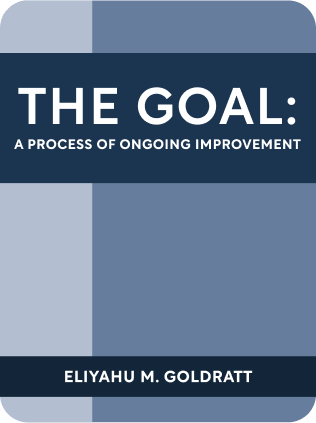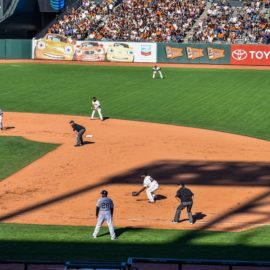

This article is an excerpt from the Shortform book guide to "The Goal: A Process of Ongoing Improvement" by Eliyahu M. Goldratt. Shortform has the world's best summaries and analyses of books you should be reading.
Like this article? Sign up for a free trial here .
Who is Alex Rogo in The Goal? How does his story help contextualize the key points of the book?
Alex Rogo is the protagonist of The Goal. He is the manager at a manufacturing plant that is struggling with its production. The strategies he uses are lessons for anyone looking to improve output.
Read on for more about Alex Rogo and how his story is an allegory.
The Story of Alex Rogo
As an allegory, The Goal is explication of a philosophy with a fictional novel wrapper.
This has various effects beyond pure entertainment value. Portraying the protagonist’s struggle makes you empathize and absorb the teachings better. Unlikable characters stereotype critics of the philosophy (like Eddie, who doesn’t ever question the traditional way of doing things). Overcoming the struggle paints a vivid picture of how the strategy can work.
However, at times the dialogue and epiphanies in The Goal book can feel forced, and the conversations don’t sound natural.
Thus, we consider the plot to be a minor portion of the value of the book. Here’s the summary, for context:
The Problem
Alex Rogo is a beleaguered plant manager in a small manufacturing town. They’re in a bad situation: large backlog of orders, all orders are late unless expedited.
Company policies are to blame. The division’s goal has been to increase cost efficiencies, so they focus on local efficiencies of production (like the fallacy, “we have to keep the robots running at all times or else the cost per part will go up and we’ll never make back the cost.”). Large inventories accumulate, and they add robots without increasing sales.
Their entire division has 3 months to improve performance or it’ll be sold.
Trying to Find Solutions
Alex Rogo talks to his old physics professor Jonah throughout all this. Jonah feeds him insight piecemeal, and Alex uses it to solve each problem, only for another to appear.
Alex ponders the problem. Why didn’t adding robots increase throughput? Humbled, Alex is prompted to find the bottleneck of the plant.
On a boy scout hike, Alex realizes the fallacy of the balanced plant and how to identify and resolve bottlenecks.
At the plant, they identify two bottlenecks – the new robotic machine, and heat treatment.
But after identifying bottlenecks, it’s not clear how to increase capacity. They realize the bottleneck machine is idling at times because of union rules; also, the heat treatment inefficiently runs small loads.
They reorder the work queue so that the bottleneck is working only on the oldest unshipped orders. They clear the idle time with the union rep.
They run into an issue where the bottleneck doesn’t have upstream parts available. They learn the non-bottlenecks are working on non-bottleneck parts. They put red tags on bottleneck parts so that those always get highest priority.
Making Progress
They start filling their backlog and reduce their lead time. But it’s not enough to clear the backlog entirely.
- They add an extra outdated machine that will increase capacity at the bottleneck, albeit inefficiently.
- They start collecting better data about the performance at their bottlenecks.
- They load and unload at heat treatment immediately, letting workers idle there instead of letting the bottleneck idle.
New bottlenecks seem to emerge. It turns out they’re releasing too much upstream material and focusing on producing red bottleneck parts only, leading to a deficit of green non-bottleneck parts.
- They utilize a drum-buffer-rope system to limit the release of materials upstream to synchronize with the bottleneck.
They reduce batch sizes, which decreases their lead times. Sales increase as reputation grows.
Alex’s plant gets a 1000-unit million-dollar order to be delivered within two weeks. They initially consider it impossible, but they cut batch sizes again and offer to ship the 1000 units in 4 weekly shipments, starting 2 weeks from then. They make this happen.
Success at Last for Alex Rogo
Alex’s boss gets promoted to headquarters, and Alex becomes division manager. He gets tasked with finding out how to become a manager. He realizes he needs to learn to figure out problems for himself, rather than consulting Jonah.
Throughout all of this, there is a secondary storyline with Alex Rogo going through marital turmoil with his homemaker wife. The stress over losing the factory makes him miss dinner dates, they communicate poorly, and his wife leaves for her parents. Over time they reunite as Alex turns his factory around and gains clarity.

———End of Preview———
Like what you just read? Read the rest of the world's best book summary and analysis of Eliyahu M. Goldratt's "The Goal: A Process of Ongoing Improvement" at Shortform .
Here's what you'll find in our full The Goal: A Process of Ongoing Improvement summary :
- How to increase your personal output
- How to increase your team's output
- Why obsessing over cost efficiency isn't going to help you with production






